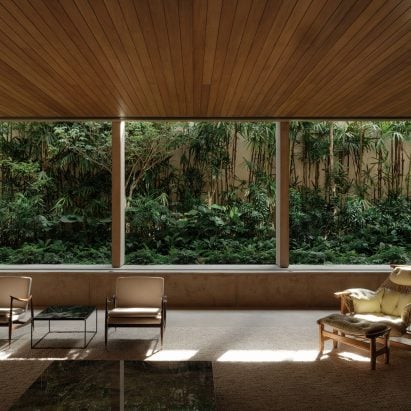A concrete grid frames views of a leafy garden at this home in São Paulo, completed by local architects Gabriel Kogan and Guilherme Pianca in collaboration with Clara Werneck.
Located close to the city centre, the home called Rua Polônia House occupies a narrow 42-by-15-metre plot that is set back from the street.
Responding to this site, Gabriel Kogan, Guilherme Pianca and Clara Werneck contrasted a more austere, street-facing frontage with an open concrete frame along its western side, behind which full-height glazing provides every space with garden views and ventilation.
Gabriel Kogan and Guilherme Pianca have designed a concrete home in São Paulo
“Tropical plants are framed by the building’s geometry, turning the landscape into an almost inward projection,” Gabriel Kogan and Guilherme Pianca told Dezeen.
“The house is designed as a sequence of framed views, emphasising frontality and depth, and minimising diagonals. There’s also a strong intention to unify function, structure, and material finishes into a coherent architectural language,” they added.
The interiors of Rua Polônia House are defined by its concrete grid, which is formed of 2.9-by-3-metre modules that repeat across its two storeys.
Full-height glazing lines Rua Polônia House’s western facade
At ground-floor level, this grid sits in front of a wall of full-height, timber-framed sliding glass doors that open up a large, sunken living room to the garden.
Occupying almost the entire ground floor, this living space is finished with a wood-panelled ceiling and a concrete floor, which extends out at its southern end to become a sheltered terrace with an outdoor cooking area, bar and pool.
“The sunken living room with its uniform wooden ceiling is a visually ‘silent’ space without lighting and air-conditioning elements,” the team said.
A sunken living room is held on the ground floor
On the first floor, the grid dictated the size of three bedrooms, a landing and a secondary lounge, with each room two modules wide and featuring sliding glass doors.
Above, a smaller floor containing the main bedroom sits atop this concrete frame, set back to make it “imperceptible” from the garden.
Rua Polônia House’s material palette was based on the concrete structure, which was slightly pigmented to give it a pale cream colour, chosen to contrast with the garden’s greenery.
The architects explained how they “deliberately avoided decorative layering” inside the home, using exposed concrete and wooden panelling in the living areas and stone in the bathrooms.
Concrete and wood are used across the living spaces
“Choices also considered maintenance and durability, especially in kitchens and bathrooms,” Kogan and Pianca explained.
“The material palette was developed on-site through prototyping. We used a subtle pigmented concrete to create warmth that contrasts with the surrounding greenery.”
The bedrooms are contained on Rua Polônia House’s upper floors
Previous projects by Gabriel Kogan and Guilherme Pianca include a sandwich shop in the São Paulo department of the Institute of Architects of Brazil, with a material palette drawing on 1950s influences.
Other houses near São Paulo recently featured on Dezeen include a stucco-clad dwelling by Arkitito Arquitectura that sits between terraced gardens and one by DB Arquitetos that is surrounded by wooden screens.
The photography is by Pedro Kok.
The post Concrete grid creates “sequence of framed views” at Rua Polônia House in Brazil appeared first on Dezeen.
